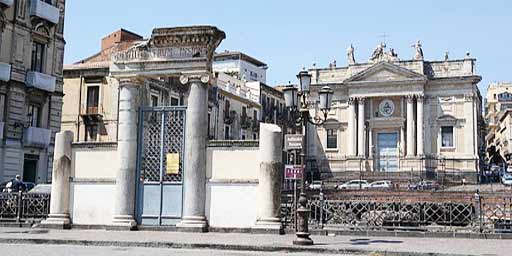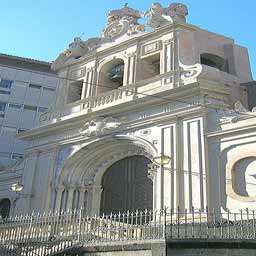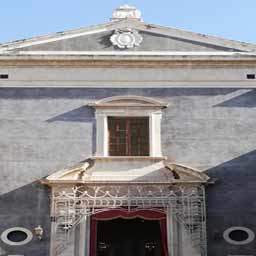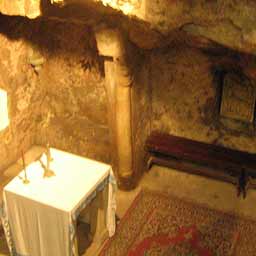Stesicoro Square in Catania
Piazza Stesicoro , which owes its name to the Greek poet Stesicoro whose tomb was here in Roman times, is crossed and divided in two by the main street in the center, Via Etnea. The two parts of the square have different architectural styles. To the east stands the monument dedicated to the composer Vincenzo Bellini. Behind the monument to Bellini, at the end of the fifties, all the existing buildings were demolished and the current Corso Sicilia was built, on the sides of which are the main financial buildings of the city. On the other side of the square, under the road surface, about ten meters deep, you can see a part of the Roman amphitheater unearthed in the early twentieth century. In front of the remains of the Amphitheater is the Church of San Biagio also known as the Church of Sant'Agata alla Fornace, from the name of the relic kept inside, and next to it in a higher position than the square is the Palazzo della Borsa, now the seat of the Catania Chamber of Commerce. To the north, with respect to the Roman amphitheater, is the eighteenth-century Palazzo Tezzano, seat of the court until 1953.
The Roman Amphitheater of Catania is a grandiose Roman monument, second in size only to the Colosseum, whose external circumference should measure about 300 meters, and is almost completely covered by modern buildings. The grandeur of the monument is in fact perceptible only from the remains of the walls visible in two crossbars of via Manzoni. It is believed that the amphitheater was completed during the second century AD. C. It is certain, however, as historians attest, that already at the time of Theodoric (494 - 526 AD) the amphitheater was in a state of neglect, and that the people of Catania asked the emperor for permission to use the stones as a material. of construction. It was also a source of building material for King Roger, in 1091, the lava stone of the amphitheater was used for the construction of the Cathedral of Sant'Agata and the construction of the ancient walls.
The "underground" monument is well preserved and today it is visible, looking out from Piazza Stesicoro, under the road surface.
The Monument to Vincenzo Bellini in Catania was built by the sculptor Giulio Monteverde, commissioned by the municipality of Catania, and inaugurated on 21 September 1882. The statue seems almost placed in a "strategic" position, as during the feast days dedicated to the patron saint of the city of Catania, Sant'Agata, just when the fercolo is in Piazza Stesicoro, Vincenzo Bellini himself seems to turn his gaze towards the Saint, as if to pay homage to her. In fact, it is said that the composer from Catania himself, during his youth, was very devoted to the Saint. The monument, completely in white marble, has a square base and is fifteen meters high. The base has the shape of a parallelepiped about three meters high. On this base there are seven steps, to indicate the musical notes, which rise in a truncated pyramid. At the top of the staircase there is a square-shaped column on the top of which is a statue of Vincenzo Bellini seated on a chair. On the four sides of the column there are four statues as an allegory of his four most famous works: Norma, I puritani, La sonnambula and Il pirata. A low wrought iron gate surrounds the monument.
The Church of San Biagio in Catania , also known as the church of Sant'Agata alla Fornace, was built in the 18th century after the terrible earthquake of 1693. The place where it was erected is, according to tradition, the place where the furnace where Sant'Agata suffered martyrdom was located. The facade of the church is by the architect Antonino Battaglia, who designed other churches in Catania after the earthquake of 1693, in a neoclassical style with coupled columns supporting a triangular tympanum. The interior has a single very linear and sober nave. On the main altar an eighteenth-century painting of the Addolorata, sometimes replaced by a statue of the Madonna. Ingenious the artifice of the main altar, enriched by scrolls and columns and by the statues of St. John the Evangelist and St. Mary Magdalene. Every year from the Church of Sant’Agata alla Fornace, on February 3 the religious celebrations for the patron saint of the city begin with the procession of offering wax to the saint, formerly known as the "procession of the luminaria".
The Palazzo della Borsa in Catania was designed by the architect Vincenzo Patanè as the seat of the Provincial Council of Corporate Economy and inaugurated on October 29, 1933. The three-storey building, in its main facade on Piazza Stesicoro, consists of a ground floor with very high ceiling and two floors with semicircular sixth windows. This expedient was necessary to solve the problem related to the fact that the building was built on a steep slope: at the top of the San Giuliano slope it has only two floors, one of which is ground. It is accessed by a lava stone staircase and the main facade is entirely covered with local white stone and decorated with architectural elements. The main entrance, at an angle, is surrounded by two columns that support the balcony on the first floor. All the openings on the ground floor are protected by artistic wrought iron railings. The large window on the first floor, above the main entrance, is surmounted by a broken tympanum surmounted by the coat of arms of the House of Savoy, reigning at the time of the construction of the palace. The other windows on the first floor, equipped with balustrades, are also surmounted by gables, both whole and broken. The second floor has windows without arches and is surmounted by a cornice. The whole building is embellished with rusticated pilasters.
Il Palazzo Tezzano a Catania fu costruito a partire dal 1709 su di un terreno di proprietà del conte e medico Niccolò Tezzano. Venne poi da lui donato alla città di Catania, allora duramente ferita dal terremoto del 1693 per allocarvi l'ospedale di San Marco. Dopo il trasferimento dell'ospedale intorno al 1880, palazzo Tezzano rimase sede del Tribunale fino alla costruzione della nuova sede di Piazza Giovanni Verga ultimata ed inaugurata nel 1953. All'interno di esso, attualmente, ha sede l'Archivio Ceramografico dell'Università degli Studi di Catania, costituito da un corpus di migliaia di schede di riproduzioni di vasi attici editi ed inediti di tutta Europa. L'edificio, di imponente aspetto, è di forma quadrangolare con cortile interno che la costruzione contorna formando una "U" con l'interruzione a nord. Vi si accede dalla piazza Stesicoro attraverso un ampio portone principale, posto al centro del prospetto principale, sovrastato da un balcone monumentale sopra al quale torreggia un orologio. Il prospetto è simmetrico ed è diviso nel senso dell'altezza da false colonne in pietra chiara che contrastando con il tono grigio basalto dell'intonacatura creano una suddivisione in cinque unità architettoniche per lato.



